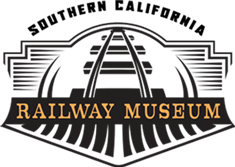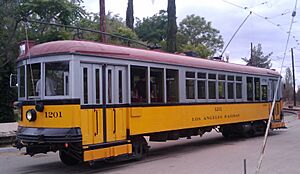Southern California Railway Museum facts for kids
 |
|
| Former name | Orange Empire Railway Museum |
|---|---|
| Established | 1956 |
| Location | 2201 S. "A" St. Perris, California |
| Type | Railroad museum |
| Collections | Electric trains & trolleys, steam & diesel locomotives, passenger & freight cars, light rail vehicles, maintenance of way equipment |

The Southern California Railway Museum (SCRM), once known as the Orange Empire Railway Museum, is a fun railroad museum in Perris, California, United States. It started in 1956 in Los Angeles. Later, in 1958, it moved to Perris and was called the "Orange Empire Trolley Museum." In 1975, it became the "Orange Empire Railway Museum." The museum got its current name in 2019. It also has a special heritage railroad where you can ride old trains.
Contents
Discovering Railroad History
The museum has a huge collection of trains and trolleys. It focuses on the history of railroads in Southern California. They have the world's largest collection of Pacific Electric Railway trains. Many of these were saved from scrapyards after they stopped running in 1961.
On weekends, you can ride old Los Angeles streetcars. These include narrow gauge streetcars or standard gauge ones from the Pacific Electric Railway. They run on a half-mile long track called the Loop Line. You can also ride a passenger train pulled by a steam, diesel, or electric engine. This train uses open cars with benches and cabooses. It runs on a 1.5-mile long main line. This line was once part of a big railway that went to San Diego.
The main line goes north from the museum towards the BNSF Railway junction. The historic Perris Depot is located there. A Pacific Electric "Red Car" also runs on the main line on some weekends. The museum makes sure to use different streetcars and locomotives. They have a steam locomotive that works. It runs on the third weekend of each month from September to May, and on special holidays.
Parking and getting into the museum are free. However, you need to buy tickets to ride the trains. Your ticket is good for all the rides on the day you visit.
You can explore the museum grounds and exhibits on your own. Or, you can have a guide show you around. There is a picnic area near the entrance. You can also find an interesting "signal garden" there.
Fun with Signals: The Signal Garden
The museum has a cool "signal garden" built between 2000 and 2001. It shows how old and new railroad signals work. It uses special parts like old signal relays and computer controls.
Here are some of the cool things you can see:
- Two restored Magnetic Flagman signals. These used to warn people at railroad crossings.
- A Safetran V20 tri-light block signal. This was a new signal used on a coastal route.
- Union Switch and Signal motorcar indicators. These were small semaphores that warned maintenance crews about trains coming.
- An ATSF motorcar indicator. This was a simple signal with lights and colored lenses.
- A large, bronze grade crossing warning bell from around 1910. This bell used to ring loudly to warn drivers that a train was coming. It was in Anaheim until the 1960s.
- A Union Switch and Signal relay cabinet from around 1940. This cabinet held the electronics that powered the signals.
The garden has grown since then. It now includes modern crossing signals. There's also a US&S semaphore that was once on a bridge over the Pacific Electric Watts Line. You can also see a very old US&S banjo signal. This type of signal is very rare, with only three known to exist.
Amazing Trains and Locomotives
The museum has many famous trains and locomotives. Here are some of the highlights:
Steam Locomotives
- Ventura County Railway 2: This Baldwin Locomotive Works steam locomotive was built in 1922. It is a 2-6-2 "Prairie" type. It's used for special events at the museum. It was donated in 1972 and has been running since 1978. As of 2025, it is undergoing a big inspection and overhaul. This process is expected to finish in 2026.
- Union Pacific 2564: This large steam locomotive was built in 1921 by the American Locomotive Company (ALCo). It's a 2-8-2 "Mikado" type. It was on display in Oro Grande, California until 1997. Then, it was donated to the museum. It is currently on display and waiting to be restored to look like new.
Diesel Locomotives
- Atchison, Topeka and Santa Fe 108: This powerful EMD FP45 diesel locomotive was built in 1967. It has a 3600-horsepower engine. It was designed for fast passenger trains, like the famous Super Chief. It was the last passenger locomotive bought by the Atchison, Topeka and Santa Fe Railway. It was donated in 1997 and is still working. It had a big six-year restoration that finished in 2018. Now it looks just like it did when it was new, with its original "Warbonnet" paint scheme.
- Southern Pacific 3100: This GE U25B diesel locomotive was built in 1963. It's the last one of its kind still working in the US. In 1976, it was painted red, white, and blue to celebrate the United States Bicentennial. It was donated in 1988 and is used regularly at the museum. It can even pull passenger cars on weekends.
- Union Pacific 942: This E8A diesel locomotive was built in 1953. It's one of 18 Union Pacific trains at the museum. The 942 is a very important part of the museum's Union Pacific collection. It has been fully restored and looks amazing in Union Pacific's yellow, red, and grey colors. Sometimes, it pulls a matching four-car passenger train called “The City of Perris.”
- Atchison, Topeka and Santa Fe 5704: This EMD SD45-2 diesel locomotive was built in 1973. It was one of five Santa Fe SD45-2s painted in special Bicentennial colors. It was donated to the museum in 2021. In 2022, it was restored to look like it did when it was first built. This locomotive arrived at the museum on May 3, 2025. The museum plans to get it working again.
- Coaster 2105: This M–K F40PHM-2C diesel locomotive was built in 1994. It was used for commuter trains in San Diego until 2021. It was donated to the museum in 2022. This locomotive arrived at the museum on May 3, 2025. It cannot run on its own engine anymore, but the museum hopes to use it as a "cab car" where a driver can control other trains.
Electric Trains and Trolleys
- Pacific Electric Collection: The museum has over 30 pieces of equipment from the Pacific Electric Railway. This was the largest electric train network in the United States. It includes passenger cars, electric locomotives, and freight cars. You can see famous cars like "Business Car" PE 1000 and "Hollywood" suburban cars. Some of these cars were even in the movie Who Framed Roger Rabbit!
- Los Angeles Railway Collection: This collection has more than two dozen electric railway cars. It's the best collection of streetcars from any big city system. Highlights include the "Descanso," which is the only surviving funeral car from a street railway. There's also car 3001, which was named by Shirley Temple. You can also see "California" type streetcars, which had a half-open design perfect for the warm weather. These cars run regularly on the only 3-foot-6-inch narrow gauge trolley line left in the United States.
Modern Light Rail Vehicles
The museum also has some newer light rail vehicles.
- San Diego Trolley Cars: Siemens-Duewag U2 cars 1008 and 1003 arrived in 2016 and 2018. They join older San Diego Electric Railway PCC cars. Cars 1008 and 1003 run on some weekends, sometimes even as a two-car train.
- Los Angeles Metro Rail Car: Nippon Sharyo P865 car 144 joined the collection in July 2018. It's the first light rail vehicle of its kind to be saved in a museum in the United States.
Behind the Scenes: Shops and Maintenance
The museum doesn't just show off trains; it also has workshops where they fix and maintain them. These shops have old and special tools. For example, they have a unique sheet-metal shear. This tool was made during World War II by a company that couldn't buy one. So, they designed and built their own! The museum still uses this special tool today.
Other important shops at the museum include:
- Machine Shop: This shop can make custom metal parts needed to fix trains. It also has the air brake shop.
- Wood Shop: This shop works with wood to maintain buildings and trains that have wooden parts.
- Communications, Electronics & LRV Maintenance Shop: This shop takes care of the museum's radio system and other electronic systems. It also maintains the modern Light Rail Vehicles, which use a lot of electronics.
- Signal Shop: This shop keeps the railway signal system working. This includes track switches, controllers, and all the parts that help trains run safely.
- Diesel Maintenance Shop: This shop maintains the museum's diesel locomotives and their engines.
- Electric Car Maintenance: This work is done in special workshops for narrow-gauge and standard-gauge electric cars.
See also
- List of heritage railroads in the United States
- List of heritage railways
- List of museums in California
- Perris Valley Historical and Museum Association
- Rail transport in Walt Disney Parks and Resorts
- Railroad Canyon
Images for kids























